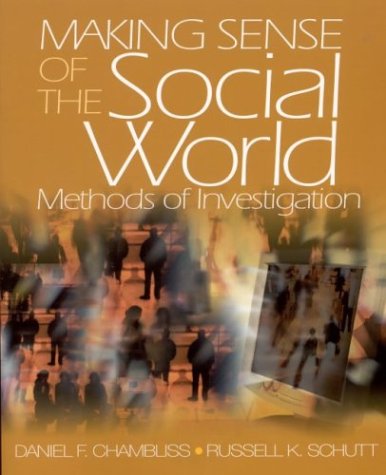Making Sense of the Social World: Methods of Investigation
Chambliss, Daniel F and Russell K. Schutt
Sage Publications, London
2003
0761987878
 Making Sense of the Social World is a well produced social methods textbook, focusing on sociology and social policy in its examples and suitable for undergraduate beginners in these disciplines. It is very North American in its tone and examples, but the British or European reader will not find these problematic (with the exception, perhaps, of some of the metaphors drawn from specifically North American sports). It comes equipped with a CD containing further review exercises, a social survey data file for use on SPSS and a qualitative analysis program (HyperRESEARCH) whose demonstration mode should be sufficient for many student projects. (You need a licence for full use.) There is also an Instructors' Manual which includes plans for group exercises in and out of class.
Making Sense of the Social World is a well produced social methods textbook, focusing on sociology and social policy in its examples and suitable for undergraduate beginners in these disciplines. It is very North American in its tone and examples, but the British or European reader will not find these problematic (with the exception, perhaps, of some of the metaphors drawn from specifically North American sports). It comes equipped with a CD containing further review exercises, a social survey data file for use on SPSS and a qualitative analysis program (HyperRESEARCH) whose demonstration mode should be sufficient for many student projects. (You need a licence for full use.) There is also an Instructors' Manual which includes plans for group exercises in and out of class.
As an introduction to 'quantitative' or 'scientific' research it is excellent. It relates the planning and conduct of research well to theoretical and applied sociology. There are excellent sections or chapters on operationalisation, measurement (in more detail than is presented by many authors), sampling, experimental and quasi-experimental design, survey design and conduct and reporting and proposing research. There is also a sound chapter on evaluation research (but without reference to the realist approach to evaluation) and a short but useful appendix on finding information on the web. One might dispute its implicitly positivistic stance ('Most research seeks to determine what causes what' - p. 14) but not the excellent detailed coverage of threats to internal validity that follows from it.
The book and the authors are less convincing when it comes to qualitative/evaluative research. This is covered in one chapter, plus a page in the middle of the chapter on evaluation and a twenty-page Appendix on using HyperRESEARCH. There is no reference whatsoever to critical or discursive research – the analysis of underlying discourse or ideology. Even within the grounded theory/phenomenology range of perspectives the authors do not succeed in conveying the same enthusiasm and personal knowledge as they show in the survey and experiment chapters; the treatment is somehow remoter, empty of the critical grasp of its purpose that qualitative research requires.
Two other weaknesses will probably make this book unsuitable for most British undergraduate courses.
1. There is virtually no coverage of inferential statistics and significance testing; the statistical analysis techniques which are presented are purely descriptive. The most the authors have to say about significance is that 'statistical significance basically means the relationship is actually there and it's not a chance occurrence' (p. 239), which is not sufficient to fuel even a reader's appreciation of what is presented in research reports. There is a 12-page appendix on the use of SPSS, but again it is insufficient for students who need to test whether differences or correlations are likely to be properties of the population rather than just the immediate sample or to assess the significance of a third variable's effect. A supplementary text on statistics would be needed even for research methods classes and certainly for students required to carry out empirical projects.
2. The approach lacks the appreciation of epistemology and ontology which has become characteristic of British methods teaching in the past decade. There is no discussion of the status of truth, of confirmation and disconfirmation or understanding versus prediction, of the nature of impartiality in politically or ethically committed research, of the implications of sociological (or other) perspectives for research methods of the impact of world-views and models of the person on commonly conceived variables such as class, attitude or personality. The overall approach is one of 'finding out the facts' in an unexamined and uncritical way. It is symptomatic of it that internal validity is also termed 'causal validity' and is defined wherever it appears in terms of the correctness of the conclusions, not the quality of the argument that led to them.
Roger John Sapsford
The University of Teesside

